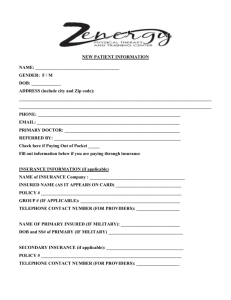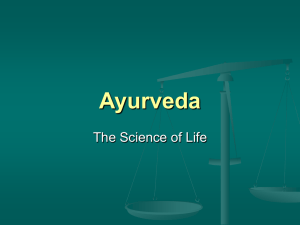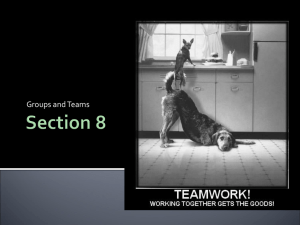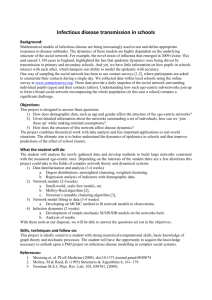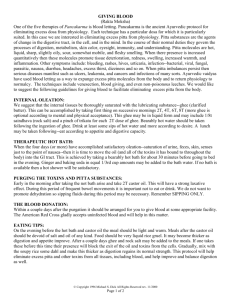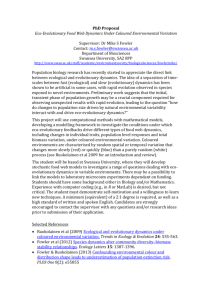Equilibrium is Not Equal by Dr. C. R. Agnives
advertisement
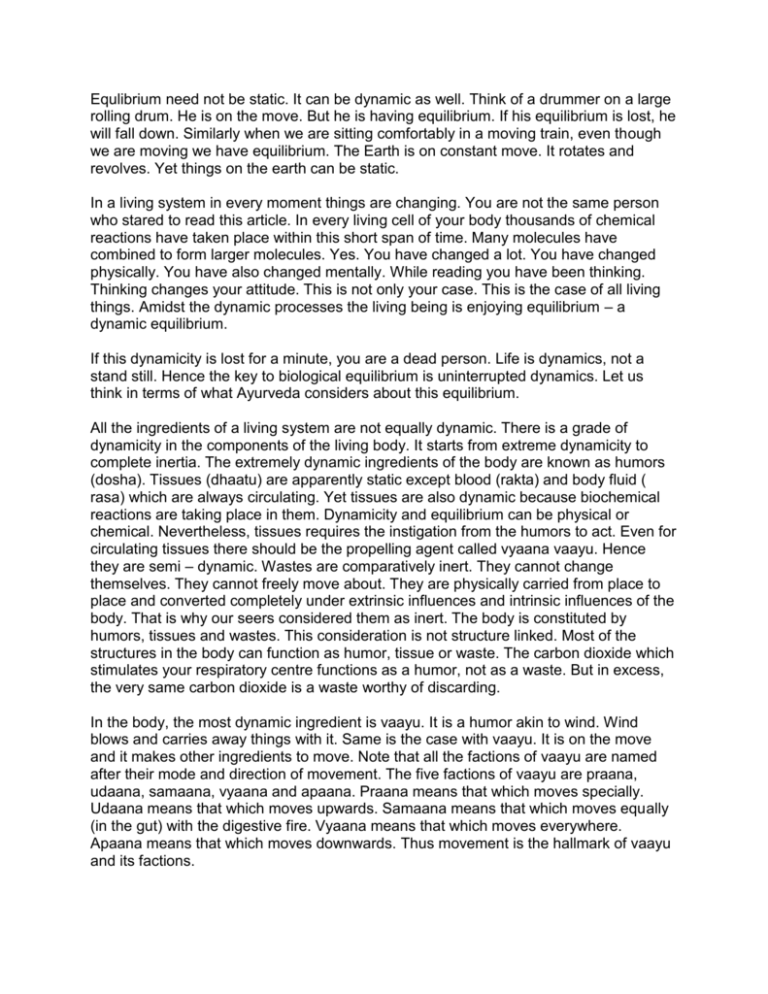
Equlibrium need not be static. It can be dynamic as well. Think of a drummer on a large rolling drum. He is on the move. But he is having equilibrium. If his equilibrium is lost, he will fall down. Similarly when we are sitting comfortably in a moving train, even though we are moving we have equilibrium. The Earth is on constant move. It rotates and revolves. Yet things on the earth can be static. In a living system in every moment things are changing. You are not the same person who stared to read this article. In every living cell of your body thousands of chemical reactions have taken place within this short span of time. Many molecules have combined to form larger molecules. Yes. You have changed a lot. You have changed physically. You have also changed mentally. While reading you have been thinking. Thinking changes your attitude. This is not only your case. This is the case of all living things. Amidst the dynamic processes the living being is enjoying equilibrium – a dynamic equilibrium. If this dynamicity is lost for a minute, you are a dead person. Life is dynamics, not a stand still. Hence the key to biological equilibrium is uninterrupted dynamics. Let us think in terms of what Ayurveda considers about this equilibrium. All the ingredients of a living system are not equally dynamic. There is a grade of dynamicity in the components of the living body. It starts from extreme dynamicity to complete inertia. The extremely dynamic ingredients of the body are known as humors (dosha). Tissues (dhaatu) are apparently static except blood (rakta) and body fluid ( rasa) which are always circulating. Yet tissues are also dynamic because biochemical reactions are taking place in them. Dynamicity and equilibrium can be physical or chemical. Nevertheless, tissues requires the instigation from the humors to act. Even for circulating tissues there should be the propelling agent called vyaana vaayu. Hence they are semi – dynamic. Wastes are comparatively inert. They cannot change themselves. They cannot freely move about. They are physically carried from place to place and converted completely under extrinsic influences and intrinsic influences of the body. That is why our seers considered them as inert. The body is constituted by humors, tissues and wastes. This consideration is not structure linked. Most of the structures in the body can function as humor, tissue or waste. The carbon dioxide which stimulates your respiratory centre functions as a humor, not as a waste. But in excess, the very same carbon dioxide is a waste worthy of discarding. In the body, the most dynamic ingredient is vaayu. It is a humor akin to wind. Wind blows and carries away things with it. Same is the case with vaayu. It is on the move and it makes other ingredients to move. Note that all the factions of vaayu are named after their mode and direction of movement. The five factions of vaayu are praana, udaana, samaana, vyaana and apaana. Praana means that which moves specially. Udaana means that which moves upwards. Samaana means that which moves equally (in the gut) with the digestive fire. Vyaana means that which moves everywhere. Apaana means that which moves downwards. Thus movement is the hallmark of vaayu and its factions. Both pitta and kapha, the other two humors, can effect metabolic changes. But they are not capable of moving about all by themselves. Tissues respond to the stimuli given by the humors and react according. Wastes are not capable of moving or reacting, but they are physically carried by vaayu from place to place. Thus in essence, excepting vaayu, no other ingredient of the body can move about freely. That is why it is mentioned that pitta, kapha, tissues and wastes are paraplegic (pangu) and they just go to places carried by vaayu, analogous to clouds carried away by wind. In considering the equilibrium of the body, the movements as well as the biochemical reactions of its ingredients are important. There are various migrations for the humors in the body. Of them the migration from the site of origin to the site of work and return is most important. The place of origin of the humors is the gastroenteric tract. They are produced during the different stages of digestion. These stages may be arbitrarily divided into three phases – The gastric phase, intestinal phase and rectal phase (or large intestinal phase). These phases are approximately occurring in stomach, small in testine and rectum and the vicinity (though not anatomically exact) may be correlated to the chest, abdomen and pelvis, the three divisions of the visceral cavity or torso. These areas are morphologically demarked on the trunk by the xiphoid process of the sternum (hrt) and the umbilicus (naabhi). The area of trunk above the xiphoid is considered as chest (uras), the site of origin of kapha. The area of trunk in between the xiphoid and the umbilicus is considered as abdomen (udara), the site of origin of pitta. The area of trunk below the umbilicus is termed pelvis (sroni), the site of origin of vaayu. From these sitesof origin the humors are actively absorbed and they reach every nook and corner of the livingbody according to biophysical phenomena. Once they reach there, they return back to their sites of origin whenever necessary to be reinforced. This is similar to the travel by a person from his home village to working place in town and back. The dynamic equilibrium of the humors is responsible for the maintenanace of health. A certain amount of fluctuation is to permitted for any dynamic entity as dynamicity demands movement. Hence do not expect the humors to be at a fixed value, the amount of each humor also has a normal range. This normal range varies from person to person according to humoral constitutions. Thus a vaata person will have high set normal range for vaata than other constitutions. Similarly a pitta person will have a high set normal range for pitta. In trihumoral (equal) constitution the normal range of all the three humors will be about the mid – horizontal line (x – axis) of the of humoral range [graph 1]. Increase and decreases of humors well within the normal constitutional range of a person do not tamper his health. Diurnal variations occur usually within this normal range. Out side the upper and lower limits of this there is another range which can be considered as borderline ranges. The upper range is the range of accumulation of the humors. In the stage of accumulation the humor will increase above the normal range. Yet there is no disease at this stage. But the body will initiate its reaction against the increase of the humor. That is why in the stage of accumulation, the person experiences aversion towards the causes of increase of the humor. This is a normal feedback reaction. The sensors of humors in the body which keep constant watch over the quantity and quantity of the humors in the body starts giving off warning signals to controlling nervous and hormonal systems that maintain the equilibrium of the internal environment, commissioning them to respond to the increase of the humor. Only when the humor goes out of this range of accumulation, disease sets in and signs and symptoms manifest. This is the stage of aggravation. That is a stage when the increase of humor cannot be handled by the self adjustment system of the body and hence disease sets in. Now a hazard management troop is to be heralded by the body. The hazard management troop of the body is the immune system. This system fights against the disease and its causes. If the immune system wins the pathogenic agents are destroyed or brought under control and the disease will subside. All our efforts of treatment are to assist, reinforce and replenish the immune system engaged in war against disease. Hence medical system is akin to the Army Supply Corps. It need not fight, but should assist the fighters. If the immune system loses the war against disease, the body will have to surrender to the disease and life is at stakes. Death or deformity is the result. Thus we find that there are two types of dynamics for the humors. The first dynamics is normal and the second one is abnormal. When a person is healthy the humors will be having normal dynamics. The abnormal dynamics is pathology. Normal dynamics has two stages humors well within normal range and humors entering into the borderline range. When the borderline limit is trespassed and the humors enter the pathologic range diseases manifest. In a way, the borderline range can be considered as a no man’s land for health and disease. The changes in the dynamics of the humors occur due to internal and external influences. The living body as a microcosm is constantly reacting to the influences of the macrocosm. Day, night and seasons change the external environment and as a reaction to these variations the humors increase and decrease in the body. Age is an intrinsic factor that changes the rate of biochemical activities taking place in the body. Digestion is another intrinsic factor but since food is a foreign object, it has extrinsic implications too. Activities are also intrinsic as they are generated by the body. But activities also have extrinsic factors. For example bathing in cold water and warm water has different influences on the body. Changes of flow of wind, ionic changes of the atmosphere etc. have a say on the humoral dynamics of the body. Now we shall examine the various normal dynamics of the humors. The following dynamics of humors are mentioned in the first chapter of the part of aphorisms of Ashtaamga – hrdaya. 1. Daily dynamics – a) Diurnal dynamics and b) Nocturnal dynamics. 2. Age related dynamics 3. Digestion related dynamics. The book details another dynamics in the twelfth chapter of the same part. This is the Seasonal dynamics and it occurs in the borderline range. Seasonal dynamics can be initiated even by provocative food and activities even without seasonal support. Since it is in the borderline range and trespassing to pathologic range in the stage of aggression (kopa) seasonal dynamics should be considered as a patho- physiological phenomenon. Purely pathological dynamics does not come under the purview of this article. Let us have a brief survey of the normal dynamics and marginal dynamics of humors. Diurnal dynamics Kapha, pitta and vaata increase in the morning (6 – 10am), noon (10am – 2pm) and afternoon ( 2- 6pm) respectively. [The timings are under the assumption that sun rises at 6am and sets at 6pm]. Morning is comparatively cold and stagnant. This rising sun starts to heat up earth. Hence the time is akin to spring season when the snow melts. This causes the increase of kapha. Noon is hot and it causes the increase of pitta. Pitta is the only hot humor. According to the law of similarity hot time should increase pitta. Afternoon is comparatively cold and the body is tired after the days work. There is depletion of tissues at this phase and it prompts the increase of vaata. Nocturnal dynamics Night also may be divided into three parts – early night (6-10pm0, midnight(10pm-2am) and late night(2-6am). Early night is the period of kapha, midnight is the period of pitta and late night is the period of vaata. Midnight is considered to have the properties of autumn. Autumn is the period of aggravation of pitta. Hence it is natural that pitta increases at midnight. In the late night cold increase and prompts vaata to increase. Daily dynamics Both daytime dynamics and nocturnal dynamics put together constitute the daily dynamics. This is a cyclic phenomenon having six phases passing through increases of kapha, pitta and vaata twice in 24 hours. The changes in daily dynamics is trivial and do not cause diseases. But if there is predisposition for disease, or when a pathodynamics has already set in, the period of the concerned humor can trigger the disease or aggravate it as here the humor is not well within the prescribed normal range. It is like the last person entering a crowded boat causing it to sink. That is the clinical significance of daily dynamics. A pain in leg increasing in the evening or late night is of vaata predominance. An abdominal pain aggravating in noon or midnight is of pitta predominance. A headache worse in the morning is of Kapha predominance. Age related dynamics Childhood is predominantly anabolic and the anabolic humor kapha is more in this period. Growth is the hallmark of childhood. Growth means increase of body bulk. This can be caused only by the anabolic humor responsible for energy conservation. Hence in childhood kapha is increase. In youth the biochemical reactions are at a peak and energy expense for activity is maximal in this period. Hormonal activities are also enhanced in this period and hence youth is a period of maximum energy utilization. The exothermic reactions are more in youth. Hence this phase of life is considered as pitta period. Old age is degenerative. Degeneration causes aggravation of vaata. Aggravation of vaata occurs due to degeneration of tissues and by blocks. Both occur in old age. They result in diseases of vaata. Hence old age is marked by increased of vaata. The diseases of child hood, youth and old age are predominantly of kapha, pitta and vaata orgin respectively. this is the clinical significance of age related dynamics. Even a kapha disease in the old age will have the backing of vaata. This should be lept in mind during diagnosis and prescribing therapy. We cannot say that the age related dynamics is strictly well within the normal range even though it is normal for the age group. The humor pertaining to the age group is in the borderline range. For example in old age vaata is in the borderline range and given chance it will trespass the upper limit and enter pathologic range causing disease. Age related dynamics is linear and not cyclic. Digestive dynamics We have seen that digestion has three phases. In the gastric phase there is augmented mucous secretion to soak the ingested food. The digestion at this phase generates kapha. This fresh supply of kapha to the system increases the stock of kapha. But normally this increase is well within normal range. The intestinal phase is the active stage of digestion and lots of digestive enzymes are secreted. This results in the production of pita. Hence in this stage pitta increases. The Third phase called the rectal or colonic phase is the phase of absorption. This is a desiccating stage and the dryness of the process increases vaata. The digestive dynamics is cyclic because when the third phase is nearing completion the stomach will empty and the person will be prompted to take food again. Seasonal dynamics The seasonal dynamics is also cyclic, the phase f aggression trespass the limits of borderline range and enter the field of pathology. This should be prevented at the phase of accumulation itself. The dynamics is tabulated below for brevity. The humors undergo accumulation, aggravation and subsidence in consecutive and appropriate seasons. We should prevent aggravation at the stage of accumulation and it will be difficult to bring back the humor to normalcy. It is like a flood. It will occur quickly but it will take a long time for the water to recede. During the rise of water, the flood will cause maximum irreparable damage. No 1 2 3 4 5 6 Table 1 Seasonal Dynamics Of Humors Vaata Pitta Season Late winter (sisira) Spring (vasanta) Summer (greeshma) Accumulation Rainy season (varsha) Aggravation Autumn(sarat) Subsidence Early winter Accumulation Aggravation Subsidence Kapha Accumulation Aggravation Subsidence The cause of accumulation and aggravation are also mentioned in Ashtaamga – hrdaya. They are tabulated below No 1 2 3 4 5 6 Table 2 Properties of seasons and Seasonal dynamics of humors Season Character of Season Additional State of humor characters Summer Hot (against vaata) Dryness etc. Accumulation of vata Rainy Cold (similar to vaata Dryness etc Aggravation of vaata & against pitta) Sharpness etc. Accumulation of pitta Autumn Hot (similar to vaata & Sharpness etc. Aggravation of vaata against pitta) Subsidence of vata Winter Cold (against pitta & Heaviness etc Subsidence of vaata Similar to kapha) Unctuousness etc Accumulation of kapha Spring Hot (against kapha Unctuousness etc Aggravation of kapha but melt it) Summer Hot (against kapha) Dryness etc. Subsidence of kapha A humor aggravates when all the properties of the humor are available in the exterior. But the two major properties hot and cold are the decisive factors. In summer all the properties of vaata except coldness are available. Hence vaata accumulates but it cannot aggravate because summer is hot. Similarly pitta does not aggravate in rainy season as the season is cold. In the case of the kapha there is a paradox. In winter all the properties of kapha are available. But it can only accumulate and cannot aggravate. This is because winter solidifies the humor. For aggravation, the humor should go out of its abode. For this an overflow of the humor is needed. Solidified kapha cannot flow out. It is stationary. Hence aggravation is not possible. But when the warmth of spring melts kapha the already accumulated humor flows out and enters the phase of aggravation. Table 3 Months, Seasons and Status of humors No 01 2 3 4 Month in Sanskrit Maaghah (tapah) Approximately corresponding period Mid January to mid February Phaalgunah (tapasyah) Caitrah (madhuh) Mid February to mid March Mid March to mid April Vaisaakhah Mid April to mid may Season Sanskrit State of humor Later Winter sisirah Kapha accumulates Spring vasantah Kapha aggravates 5 6 7 (maadhavah) Jyeshthah (sucih) Aashaaadhah (Sukrah) Sraavanah (nabhah) Mid May to mid June Summer Mid June to mid July Mid July to mid August Rainy Season 8 Bhaadrapadah (nhahasyah) Mid August to mid September 9 Aasvinah (Ishah) Mid September to mid October 10 Kaartikah (oorjah) Mid October to mid November 11 Maarga seershah (Agrahaayana) Mid November to mid December 12 Paushah (sahasyah) Kapha subsides greeshmah Vaata accumulates Autumn (Falls) Earlier Winter Varshah sarat hemantah Vaata subsides Pitta accumulates Vaata subsides Pitta aggravaes Pitta subsides (Kapha may start accumulation) Mid December to mid January The significance of seasonal dynamics is that to prevent diseases we should intervene at the time of accumulation itself. The seasonal regimens prescribed by Ayurveda are designed to prevent event accumulation of humors and when there is accumulation to prevent aggravation. Those who are fanatic lovers of nature can hold that seasonal changes in the body are natural and we need not interfere in them. But Ayurveda is not that fanatic about surrendering to the nature. Ayurveda respects the nature, tries to understand it but will not permit the nature to tamper with health. Hence Ayurveda advocates preventive and curative measures to protect life from seasonal atrocities. Graph I – Hypothetical Trihumoral Ranges Y axis Death Pathologic Increase ------------------------------------------------------------Borderline Increase -------------------------------------------------------------Normal Range -------- -- -- -- -- -- -- -- -- -- -- -- -- -- -- -- -- -- -- X axis -------------------------------------------------------------Borderline Decrease -------------------------------------------------------------Pathologic Decrease Death -------- Kapha -------- Pitta -------- Vaata
